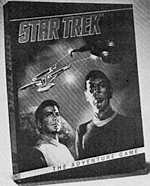
Designed by Greg
Costikyan and Doug Kaufman
West End Games Inc.
251 West Ah St,, New York,
NY116001
Released: February 1985
Catalog No. 11004
Price: $16.00
Complexity: Beginner
Solltaire Suitablity: Excellent
****
It always seemed to me that Star Trek was a modern-day reprise of the science-fiction pulps of the 1920s and 1930s. Technology was something to he taken for granted; just don't ask how things happened. The show was interested in ideas with more than a healthy dose of space opera. Fun and intellectual playing around were the show's hallmarks, and let the hardware be damned.
Odd, then, that it gave rise to a generation of detailed, technical games. The goofy, parlor philosophizing of Kirk and company was gone, replaced with hard- headed scientific fiction.
Fortunately, Greg Costikyan and Doug Kaufman have come to rescue with the aptly named Star Trek -The Adventure Game. It may be late in arriving, but if you enjoy the show, the same quirky adventures await you inside this game.
The game features over 120 different adventures for both Federation and Klingon players. Worlds are discovered, races encountered, and coolheaded (or is it quick- tempered?) captains make decisions that, one hopes, will be logical. The components are beautifully done, the best yet for West End Games Inc. The mounted map board displays the colorful Federation and Klingon empires, and the Organian treaty zone between them. Forty worlds are included, all unique and each keyed to the paragraph book. The 60-page paragraph book has over 800 entries that determine the success of the various landing parties.
Star Trek - The Adventure Game is fun to play. While hard-core gamers may want more to do such as having more control of planetary exploration, for an evening's fun, it can't be beat. its replay value, though, seems to be a steadily declining factor, as the more you play, the more you're likely to duplicate worlds. But with 800 entries, this Star Trek provides more than enough challenge.
The rules are clearly presented with illustrations indicating the use of all the markers. These include familiar Klingon and Federation space ships, space bases, and Counters with the likenesses of the jaunty Enterprise crew and some solemn-looking Klingons.
Players begin by placing all their officers and crew on starships. Each officer has different skills (navigation, communication, charisma), and the skills are slightly different for the Federation and the Klingon Empire. You can put all the Enterprise gang on one ship if you wish or divide them among four different ships. Each moving ship must have at least one officer.
Then each player rolls a dice to see who has the initiative. That player goes first and moves all his ships. A ship can move up to 12 spaces (14 with an engineer), but its dilithium crystals fail if you roll under the number of spaces moved using two dice. Failed crystals force your ship to limp back to a base for repair.
If a player's starship is at an unexplored star, he can draw a planet disk and start an adventure. This sends the player to the paragraph book, where each planet can yield a variety of encounters. Sometimes you may have to beam down a landing party, and who's on board and who's on the planet can become quite an important matter. Once the encounter begins, the skills of each officer become important. If the officer is on the planet, with the right skill, certain things happen. When there are two possibilities, the player can select the most attractive option.
As each encounter ends (and remember, these are no dry, interstellar shoot- outs), the player receives the results. Reputation, political influence, and the lives of the party can all be affected
The object of the game is for each player to increase the political influence of his group by winning over planets. While players really play on their own exploring a planet and deciding what to do, there is some room for interference with the other side.
The Federation has three High Commissioners who can help swing a planet around to a more favorable view of the Federation. The more pragmatic Klingons employ secret agents ready to subvert a neutral planet, sabotage a Federation ship, or assassinate a commissioner. Combat between the two forces is, of course, forbidden by the super powerful Organians.
The adventures contained in the paragraph book are alive with the feeling of Star Trek. Many of these are reminiscent of some of the more whimsical episocles, so don't be surprised if you run into cowboys or gangsters. Other science fiction touchstones are found in the adventures, including the intriguing world of Forbidden Planet.
Before you begin an encounter you'll get a short, fairly unhelpful description of the planet and a rating on what the game calls its Richter Scale of Culture. But surprise here is the name of the game.
The game plays quickly and there are plenty of worlds for you to discover. While I might have wanted more control over the encounters, the game's ease of play and entertaining adventures will make it very popular indeed.
And for the real fans of the Final Frontier, this is the game you've been waiting for.
More War Game Reviews
-
Game Review: Sixth Fleet
Game Review: Star Trek: The Adventure Game
Game Review: The Falklands War: Naval Combat in the Missile Age
Game Review: Battle of Chickamauga
Game Review: Schnellboote: Tactical Small Craft Warfare 1939-45
Game Review: Reinforcements for Assault (US and Soviet)
Back to Table of Contents -- Game News #6
To Game News List of Issues
To MagWeb Master Magazine List
© Copyright 1985 by Dana Lombardy.
This article appears in MagWeb (Magazine Web) on the Internet World Wide Web.
Other military history articles and gaming articles are available at http://www.magweb.com